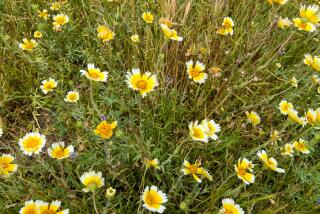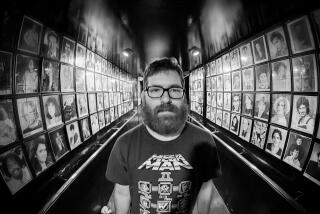D. H. Lawrence’s Afterglow in Taos
TAOS, N.M. — On a hill above Kit Carson’s grave, in a house that was once the artistic and social center of Taos, more than a dozen colorful bathroom windows glow brightly in the chill desert night.
In a room behind the mailboxes of the La Fonda Hotel on Taos Plaza, nine rather primitive oil paintings, branded pornographic and banned in Britain, hang among the memorabilia of the inn’s owner.
The windows and the nine canvases are products of the hand that also gave the world some of the most controversial studies of sex and love in the 20th Century in novels such as “Women in Love” and “Lady Chatterly’s Lover.”
Times change and standards change, and in the late 20th Century the name of British author D. H. Lawrence is seldom heard outside of literary circles.
The paintings, however, prove that Lawrence is a definite part of Southwestern U.S. history.
In Taos, Lawrence encountered the Pueblo Indians, whose religion awakened in him a new sense of time. He touched the lives of three women who gave shape to Taos’ social life for nearly half a century.
In one sense Lawrence was similar to the thousands of tourists who return to Taos every year to recharge batteries worn down by city life. Lawrence, too, thrived in the “magnificent fierce morning of New Mexico.”
He loved the pristine mountains and the shadows of clouds blowing across the sagebrush-dotted desert.
He spent relatively little time there, less than two years spread over three visits in the early ‘20s, but his impact on Taos was great. He worked on several books about 15 miles north of the town at a ranch given him by Mabel Dodge Luhan, a social maverick of the Dodge family who had brought Lawrence to Taos.
For years thereafter her large adobe hacienda was a salon for the artistically great and near great, people who were attracted by the magic of Taos and by Lawrence’s mythic figure.
Luhan’s efforts made Taos into an internationally known mecca. Since her death in 1962 her books, as well as the speculations about her relationship with Lawrence, have become a part of the Taos heritage.
Also a part of the heritage are the Luhan house’s bathroom windows, painted by Lawrence to keep the prurient from gazing upon Mabel during her ablutions. The purpose sounds un-Lawrentian, but perhaps in every would-be satyr lurks a touch of the puritan.
On Lawrence’s second visit to Taos he brought his wife, Frieda, and a young English painter, Dorothy Brett. An example of their collaboration is a pastoral painting of ranch life to which all three contributed.
That painting hangs rather incongruously among the nymphs and fawns of Lawrence’s “banned in Britain” paintings.
It stands out among them for its technical skill, perhaps an indication of the skill that was to lead Brett to become internationally known for her paintings of Taos Indians.
She stayed on after the Lawrences had left, and fanned the flames of both the Lawrence and the Taos cults until her death in her 90s just a decade ago.
Return to Taos
After Lawrence died in France in 1930, Frieda returned to the Taos ranch to remember, to write, and to act as something of a surrogate for the Lawrence devotees who made the pilgrimage to Taos in his honor.
With the help of her next husband, Angelino Ravagli, she built a small chapel to Lawrence’s memory on the mountain up from the ranch house, and there placed his ashes.
Until her death in 1956 Frieda could be drawn into arguments over what Luhan or Lady Brett had contributed to Lawrence’s life.
But only Frieda Ravagli is buried at the Lawrence chapel, in front, slightly to the left of the entrance. The space to the right is vacant.
The Taos visitor can spend half a day touching base with these relics of D. H. Lawrence. The easiest to reach are the paintings off the decorated lobby of La Fonda Hotel on the south side of Taos Plaza a couple of blocks from the popular Taos Inn.
The La Fonda receptionist collects a dollar admission and ushers visitors to the paintings. Documents in the room record the paintings’ history. Among the many photos hanging with the paintings are several by Brett, inscribed to La Fonda’s owner.
The Luhan house, Las Palomas, is northeast of the plaza, a short drive or a 20-minute walk away. Go east on U.S. 64 from the north side of the plaza. Morada Lane is the third turn to the left, paved as it meets the highway.
Getting to the Lawrence Ranch takes a car. If the weather has recently been wet, it’s good to call the ranch, (505) 776-2245, for a report on the condition of the unpaved roads.
From downtown Taos, drive north on New Mexico 3 toward Questa. About 13 miles out is a marker for the Lawrence Ranch and a right turn to San Cristobal.
Take the right branch of that road three unpaved miles to the conference center, and then go another mile or so to the original ranch house.
The road to Lawrence Ranch is a road not taken by the typical Taos tourist. But taking it is a journey into part of Taos’ past, and at its end is a bit of the mystery that remains D. H. Lawrence.
Two Taos hotels, both on North Pueblo Road, are convenient for visitors who want to look for traces of Lawrence.
The Taos Inn, P.O. Drawer N, Taos 87571, phone (505) 758-2233, offers comfortable double rooms, some with fireplace, for $50-$75, and is on the National Register of Historic Places.
A bit north of the center of town is Kachina Lodge, P.O. Box NN, Taos 87571, phone (505) 758-2275, a Best Western motel with doubles from $45 to $65.
The Taos Inn contains one of the area’s finest restaurants, Doc Martin’s, which features original New Mexico specialties.
More to Read
Sign up for Essential California
The most important California stories and recommendations in your inbox every morning.
You may occasionally receive promotional content from the Los Angeles Times.










